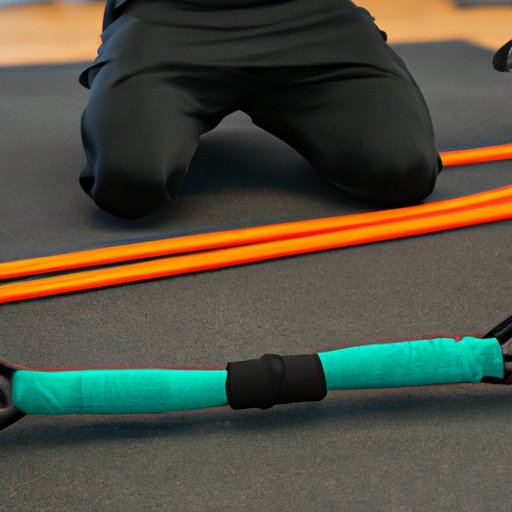Introduction
Have you ever heard of the term “RPE” in the context of fitness? RPE stands for “rate of perceived exertion” and it is a tool used to measure intensity levels during physical activity. It is an important concept to understand if you want to reach your fitness goals and maximize your performance. In this article, we will explore what RPE means in fitness, as well as how you can utilize it to enhance your workouts and achieve optimal results.

Comprehensive Guide to Understanding RPE and Its Benefits
RPE is a scale used to measure the intensity of physical activity. It is based on how hard you feel like you are working at any given moment. The scale ranges from six to twenty, with six being no effort at all and twenty being maximum effort. This scale is subjective, meaning that it is based on your individual perception of intensity.
When using RPE, you can adjust the intensity of your workouts to match your goals. For example, if you are trying to lose weight, you may want to keep your RPE between twelve to fifteen. If you are trying to build muscle, you may want to push yourself to a higher level of intensity, such as sixteen to eighteen. By understanding how to use RPE to your advantage, you can make sure that you are getting the most out of your workouts.

Exploring Different Types of RPE and Their Uses in Fitness
RPE can be used for all types of fitness activities, including cardiovascular exercises, strength-training exercises, flexibility and stretching exercises, and more. Let’s take a closer look at each type of exercise and how RPE can be used to enhance your workouts.
Cardiovascular Exercises
Cardiovascular exercises are activities that increase your heart rate and breathing rate, such as running, cycling, swimming, and walking. When doing these types of exercises, you should aim for an RPE of twelve to fifteen. This will ensure that you are pushing yourself enough to get the most out of your workout without overdoing it.
Strength-Training Exercises
Strength-training exercises involve using weights or resistance bands to build muscle. When doing these types of exercises, you should aim for an RPE of fifteen to eighteen. This will help you push yourself to your limits while still allowing you to stay safe and avoid injuries.
Flexibility and Stretching Exercises
Flexibility and stretching exercises are activities that help improve your range of motion and reduce stiffness. When doing these types of exercises, you should aim for an RPE of six to eight. This will ensure that you are not pushing yourself too hard, as stretching can put unnecessary strain on your body.
How to Use RPE to Enhance Your Workouts and Achieve Optimal Results
Now that you know what RPE is and how it can be used for different types of exercises, let’s talk about how you can use it to enhance your workouts and achieve optimal results. Here are some examples of exercises you can try with RPE:
- Interval training
- High-intensity interval training (HIIT)
- Circuit training
- Strength training with weights
- Yoga and Pilates
These exercises can all be modified to fit your individual needs and goals. For example, if you are trying to lose weight, you can adjust the intensity of your intervals and circuit training by increasing the RPE. On the other hand, if you are trying to build muscle, you can increase the weight of your strength-training exercises and adjust the RPE accordingly.
There are many benefits to using RPE in your workouts. According to a study published in the International Journal of Sports Medicine, using RPE can help improve your overall performance and reduce the risk of injury. Additionally, utilizing RPE can help you push yourself to reach your goals and maximize your results.
Tips for Utilizing RPE to Maximize Your Fitness Performance
Now that you know the basics of RPE and how to use it to enhance your workouts, here are some tips for utilizing RPE to maximize your fitness performance:
- Start off with a lower RPE to warm up your body before increasing the intensity.
- Pay attention to how your body feels as you exercise and adjust the RPE accordingly.
- Keep track of your RPE during each workout so you can monitor your progress.
- Increase the RPE gradually as you become more comfortable with the intensity level.
By following these tips, you can make sure that you are getting the most out of your workouts and reaching your fitness goals. Additionally, utilizing RPE can also help you prevent injuries and recover faster.

A Look at RPE and Its Role in Injury Prevention and Recovery
Injury prevention is an important part of any fitness routine, and RPE can play a key role in this. By paying attention to your RPE during your workouts, you can make sure that you are not pushing yourself too hard and risking injury. Additionally, RPE can also help you recover faster after an injury. According to a study published in the International Journal of Sports Physical Therapy, using a low RPE can help reduce inflammation and promote healing.
Conclusion
RPE is an important concept to understand when it comes to fitness. It is a tool used to measure the intensity of physical activity and it can help you reach your goals and maximize your results. By utilizing RPE during your workouts, you can make sure that you are pushing yourself enough to get the most out of your workouts without overdoing it. Additionally, RPE can also help you prevent injuries and recover faster. All in all, RPE is a useful tool that can help you reach your fitness goals and maximize your performance.
(Note: Is this article not meeting your expectations? Do you have knowledge or insights to share? Unlock new opportunities and expand your reach by joining our authors team. Click Registration to join us and share your expertise with our readers.)
